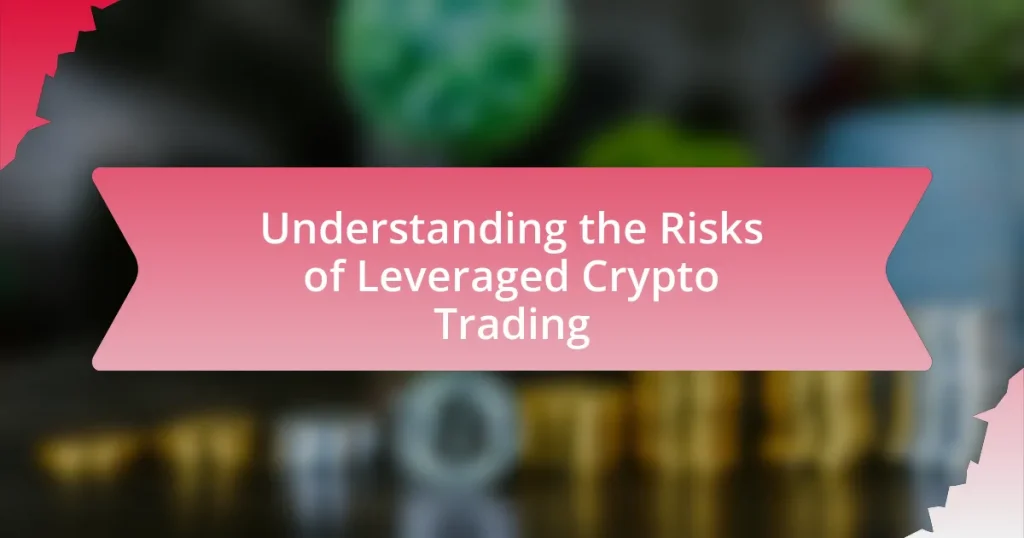Leveraged crypto trading involves borrowing funds to increase position sizes, which can significantly amplify both potential gains and losses. This article examines the inherent risks associated with leveraged trading, including the potential for substantial financial loss, increased market volatility, and the mechanics of margin and liquidation processes. It also explores psychological factors that influence trading behavior, common mistakes traders make, and effective risk management strategies such as setting stop-loss orders and diversifying portfolios. Additionally, the article emphasizes the importance of continuous education and disciplined trading practices to navigate the complexities of leveraged trading in the cryptocurrency market.

What are the Risks Associated with Leveraged Crypto Trading?
The risks associated with leveraged crypto trading include significant potential for loss, increased volatility, and margin calls. When traders use leverage, they borrow funds to increase their position size, which can amplify both gains and losses. For instance, a 10x leverage means that a 10% drop in the asset’s price can result in a total loss of the invested capital. Additionally, the crypto market is known for its high volatility; sudden price swings can trigger margin calls, requiring traders to deposit more funds or close positions at a loss. According to a report by the Financial Conduct Authority, leveraged trading can lead to losses exceeding initial investments, highlighting the inherent risks involved.
How does leverage amplify both gains and losses in crypto trading?
Leverage amplifies both gains and losses in crypto trading by allowing traders to control a larger position than their actual capital would permit. For instance, using 10x leverage means that for every $1 of their own capital, traders can control $10 worth of cryptocurrency. This means that if the price of the asset increases by 10%, the trader realizes a 100% gain on their initial investment. Conversely, if the price decreases by 10%, the trader incurs a 100% loss, potentially leading to a total loss of their invested capital. The inherent volatility of cryptocurrencies further exacerbates these effects, making leveraged trading particularly risky.
What is the concept of margin in leveraged trading?
The concept of margin in leveraged trading refers to the amount of capital that a trader must deposit to open and maintain a leveraged position. This margin acts as a security deposit that allows traders to control larger positions than their actual investment. For example, if a trader uses 10x leverage, they can control a position worth $10,000 with only $1,000 in margin. This mechanism amplifies both potential profits and potential losses, making it crucial for traders to understand the risks involved. According to the Financial Industry Regulatory Authority (FINRA), using margin can lead to significant financial exposure, as losses can exceed the initial investment.
How does the liquidation process work in leveraged trading?
In leveraged trading, the liquidation process occurs when a trader’s account equity falls below the required maintenance margin, resulting in the automatic closure of their positions to prevent further losses. This mechanism is designed to protect both the trader and the broker from the risk of negative balances. When the value of the collateral used for leverage declines significantly, the broker will issue a margin call, prompting the trader to deposit additional funds. If the trader fails to respond, the broker will liquidate the positions to recover the loaned amount. For instance, if a trader uses 10x leverage and their position loses 10% of its value, the entire investment can be wiped out, triggering liquidation. This process is critical in maintaining market stability and ensuring that leveraged trading does not lead to excessive risk exposure.
What psychological factors contribute to the risks of leveraged trading?
Psychological factors that contribute to the risks of leveraged trading include overconfidence, loss aversion, and emotional decision-making. Overconfidence leads traders to underestimate risks and overestimate their ability to predict market movements, often resulting in excessive leverage. Loss aversion causes traders to hold losing positions longer than advisable, hoping to recover losses, which can amplify financial damage. Emotional decision-making, driven by fear or greed, can lead to impulsive trades that disregard sound risk management principles. Research indicates that these psychological biases significantly impact trading behavior and outcomes, highlighting the importance of psychological awareness in leveraged trading scenarios.
How does fear of missing out (FOMO) affect trading decisions?
Fear of missing out (FOMO) significantly influences trading decisions by driving traders to make impulsive choices based on perceived opportunities rather than rational analysis. This psychological phenomenon often leads to increased buying activity during market surges, as traders fear losing potential profits. Research indicates that FOMO can result in poor decision-making, such as entering trades at inflated prices, which increases the risk of losses. A study published in the Journal of Behavioral Finance found that traders experiencing FOMO are more likely to engage in high-risk trading behaviors, ultimately undermining their long-term investment strategies.
What role does overconfidence play in leveraged trading risks?
Overconfidence significantly increases leveraged trading risks by leading traders to underestimate potential losses and overestimate their ability to predict market movements. This cognitive bias can result in excessive risk-taking, as traders may engage in larger positions than warranted by their actual knowledge or market conditions. Research indicates that overconfident traders often ignore critical information and fail to implement effective risk management strategies, which can lead to substantial financial losses. For instance, a study published in the Journal of Finance found that overconfident investors tend to trade more frequently and incur higher transaction costs, ultimately diminishing their returns.

What are the Common Mistakes Traders Make with Leverage?
Common mistakes traders make with leverage include over-leveraging, failing to manage risk, and neglecting to understand market volatility. Over-leveraging occurs when traders use excessive amounts of borrowed funds, which can lead to significant losses if the market moves against them. According to a study by the Financial Conduct Authority, 82% of retail traders lose money when trading with leverage, highlighting the risks associated with high leverage. Additionally, many traders do not implement stop-loss orders, which are essential for limiting potential losses. Neglecting to account for market volatility can also result in unexpected margin calls, forcing traders to liquidate positions at unfavorable prices. These mistakes underscore the importance of risk management and a thorough understanding of leverage in trading.
How can improper risk management lead to significant losses?
Improper risk management can lead to significant losses by exposing traders to excessive financial exposure and volatility. In leveraged crypto trading, where positions are amplified, inadequate risk controls can result in rapid margin calls or liquidation of assets. For instance, a study by the Financial Stability Board in 2020 highlighted that 80% of retail investors in leveraged trading experienced losses due to poor risk management practices. This demonstrates that without effective strategies, such as setting stop-loss orders or diversifying investments, traders are vulnerable to market fluctuations, which can quickly deplete their capital.
What are the best practices for setting stop-loss orders?
The best practices for setting stop-loss orders include determining an appropriate percentage or dollar amount to limit losses, placing stop-loss orders at technical support levels, and regularly reviewing and adjusting stop-loss levels based on market conditions. Setting a stop-loss at a specific percentage, such as 1-2% below the entry price, helps manage risk effectively. Additionally, placing stop-loss orders near established support levels can increase the likelihood of the order being executed at a favorable price. Regularly reviewing these levels is crucial, as market volatility can necessitate adjustments to protect against larger losses. These practices are supported by trading strategies that emphasize risk management, which is essential in leveraged crypto trading due to its inherent volatility.
How does position sizing impact risk in leveraged trading?
Position sizing directly impacts risk in leveraged trading by determining the amount of capital allocated to a trade relative to the trader’s total account balance. A larger position size increases potential gains but also amplifies losses, thereby heightening overall risk exposure. For instance, if a trader uses 50% of their capital on a single leveraged trade, a 10% adverse price movement could result in a 20% loss of their total account, significantly affecting their financial stability. Conversely, smaller position sizes can mitigate risk, allowing traders to withstand market fluctuations without substantial losses. This relationship underscores the importance of strategic position sizing in managing risk effectively in leveraged trading scenarios.
What are the pitfalls of emotional trading in leveraged environments?
Emotional trading in leveraged environments can lead to significant financial losses due to impulsive decision-making and increased risk exposure. Traders often react to market fluctuations based on fear or greed, which can result in over-leveraging and rapid losses. For instance, a study by the CFA Institute found that emotional biases can lead to poor investment decisions, with 70% of traders admitting to making impulsive trades during volatile market conditions. This behavior can exacerbate losses, as leveraged positions amplify both gains and losses, making it crucial for traders to maintain discipline and adhere to a well-defined trading strategy.
How can traders avoid making impulsive decisions under pressure?
Traders can avoid making impulsive decisions under pressure by implementing a structured trading plan that includes predefined entry and exit points. This approach allows traders to rely on their strategy rather than emotions during high-pressure situations. Research indicates that having a clear plan reduces the likelihood of emotional trading, as it provides a framework for decision-making. For instance, a study published in the Journal of Behavioral Finance found that traders who adhered to a disciplined strategy experienced lower levels of stress and made more rational decisions compared to those who acted on impulse.
What strategies can help maintain discipline in trading?
Establishing a trading plan is a crucial strategy to maintain discipline in trading. A well-defined trading plan outlines entry and exit points, risk management rules, and profit targets, which helps traders stick to their strategies rather than making impulsive decisions. Research indicates that traders who adhere to a structured plan are more likely to achieve consistent results, as it reduces emotional decision-making and enhances focus on long-term goals. Additionally, utilizing tools such as stop-loss orders can enforce discipline by automatically closing positions that exceed predetermined loss thresholds, thereby protecting capital and minimizing emotional stress.

How Can Traders Mitigate Risks in Leveraged Crypto Trading?
Traders can mitigate risks in leveraged crypto trading by employing strategies such as setting stop-loss orders, diversifying their portfolio, and using lower leverage ratios. Stop-loss orders automatically close a position at a predetermined price, limiting potential losses. Diversification across different cryptocurrencies reduces the impact of a poor-performing asset on the overall portfolio. Additionally, using lower leverage ratios decreases the risk of significant losses, as higher leverage amplifies both gains and losses. According to a study by the Financial Conduct Authority, effective risk management practices can significantly reduce the likelihood of substantial financial loss in volatile markets.
What risk management strategies should traders implement?
Traders should implement several key risk management strategies, including setting stop-loss orders, diversifying their portfolios, and using position sizing techniques. Stop-loss orders automatically close a trade at a predetermined price, limiting potential losses; for instance, a trader might set a stop-loss at 5% below the entry price to protect against significant downturns. Diversification involves spreading investments across various assets to reduce exposure to any single asset’s volatility, which is crucial in the highly volatile crypto market. Position sizing helps traders determine the amount of capital to risk on each trade, often recommended to be no more than 1-2% of the total trading capital, thereby minimizing the impact of any single loss on the overall portfolio. These strategies collectively enhance a trader’s ability to manage risk effectively in leveraged crypto trading.
How can diversification reduce risk in a leveraged portfolio?
Diversification can reduce risk in a leveraged portfolio by spreading investments across various assets, which mitigates the impact of poor performance in any single asset. In a leveraged portfolio, where borrowed funds amplify both gains and losses, the volatility of individual assets can lead to significant financial exposure. By holding a mix of assets with low correlation to each other, the overall portfolio risk is lowered because the negative performance of one asset may be offset by the positive performance of another. Research indicates that a well-diversified portfolio can reduce risk by up to 30% compared to a concentrated portfolio, as shown in studies by Markowitz on Modern Portfolio Theory. This approach is particularly crucial in leveraged trading, where the stakes are higher and the potential for loss is amplified.
What tools and resources are available for effective risk assessment?
Effective risk assessment in leveraged crypto trading can be conducted using various tools and resources, including risk assessment software, financial modeling tools, and market analysis platforms. Risk assessment software, such as RiskMetrics and Palisade’s @RISK, allows traders to quantify potential losses and assess the probability of adverse outcomes. Financial modeling tools, like Excel with Monte Carlo simulations, enable users to create scenarios that reflect market volatility and leverage effects. Additionally, market analysis platforms, such as CoinMarketCap and TradingView, provide real-time data and technical analysis, which are crucial for informed decision-making. These tools collectively enhance the ability to identify, analyze, and mitigate risks associated with leveraged trading in the cryptocurrency market.
What are the best practices for leveraging crypto safely?
To leverage crypto safely, individuals should implement risk management strategies, utilize secure wallets, and conduct thorough research before trading. Risk management strategies include setting stop-loss orders to limit potential losses and only using a small percentage of capital for leveraged trades. Secure wallets, such as hardware wallets, protect assets from hacks and unauthorized access, as they store private keys offline. Conducting thorough research involves understanding market trends, the specific cryptocurrency being traded, and the mechanics of leverage, which can amplify both gains and losses. These practices are essential for mitigating risks associated with leveraged crypto trading, which can be highly volatile and unpredictable.
How can traders educate themselves about market volatility?
Traders can educate themselves about market volatility by utilizing a combination of resources such as online courses, webinars, and financial literature focused on volatility metrics and analysis. For instance, platforms like Coursera and Investopedia offer courses specifically addressing market volatility, including its causes and effects on trading strategies. Additionally, reading books like “Volatility Trading” by Euan Sinclair provides in-depth insights into volatility as a trading tool. Research indicates that understanding historical volatility patterns can enhance traders’ decision-making, as evidenced by studies showing that traders who analyze volatility data tend to achieve better risk-adjusted returns.
What role does continuous learning play in successful leveraged trading?
Continuous learning is essential for successful leveraged trading as it enables traders to adapt to rapidly changing market conditions and improve their decision-making skills. In leveraged trading, where the potential for both gains and losses is magnified, staying informed about market trends, economic indicators, and trading strategies is crucial. Research indicates that traders who engage in continuous education are more likely to develop effective risk management techniques, which can significantly reduce the likelihood of substantial losses. For instance, a study by the CFA Institute found that ongoing professional development correlates with better trading performance, highlighting the importance of knowledge in navigating the complexities of leveraged markets.
What practical tips can help traders navigate leveraged crypto trading?
To navigate leveraged crypto trading effectively, traders should implement strict risk management strategies. This includes setting stop-loss orders to limit potential losses, which can prevent significant financial damage in volatile markets. Additionally, traders should only use a small percentage of their capital for each trade, typically no more than 1-2%, to mitigate risk exposure. Research indicates that over-leveraging can lead to rapid account depletion, as seen in the 2018 crypto market downturn, where many traders faced liquidation due to high leverage ratios. Furthermore, continuous education on market trends and technical analysis can enhance decision-making, allowing traders to make informed choices rather than emotional ones.















